Mike Vardy's Blog, page 60
May 29, 2017
The Daily Plan Bar with Mike Rohde
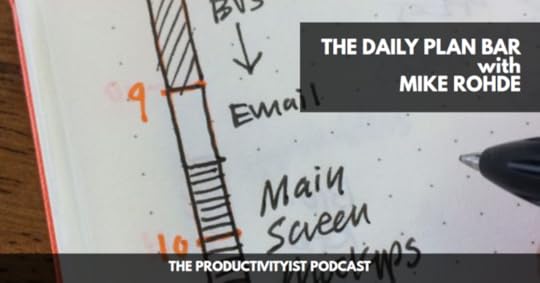
For this episode, I went out and pursued hard so I can chat with Sketchnote creator, Mike Rohde. Mike is a sketchnoter, designer, illustrator, self-professed techy, author and speaker who is fond of simple yet impactful design solutions. A sample of such is the Daily Plan Bar which he created to make task management more manageable.
Our discussion involves the origins of the Daily Plan Bar, how he came up with it and the other systems he uses to manage his work tasks and his home life.
Specific points we’ve chatted about are:
How his intention to get the most of his day, avoid distractions and just get away from the computer prompted him to maximize analog tools and create the Daily Plan bar (2:15).
Whose systems influenced and were integrated to create Mike’s Daily Plan Bar (4:43).
How he incorporates digital with analog, with his outlook calendar playing the master role from which he extracts the details of his daily plan bar (7:00).
Dealing with too many tasks, prioritizing which ones to do in the day, how Mike reminds himself of what needs to be done or focus on (8:55).
How to make a Weekly Plan Bar that integrated with the Daily Plan Bar, and how this allowed him to prioritize his tasks and see the week at a glance (11:40).
Situations when a weekly plan may not be as helpful nor practical to maintain (14:07).
How Bruce Lee’s principles based on martial arts may be applied to productivity and life (17:30).
The length of testing Mike has done before he released the Daily Plan Bar for public consumption (18:58).
What products Mike uses and how he recommends to do and utilize the Daily Plan Bar effectively (20:40).
Mike’s simpler task-management and journaling practices for home and personal purposes (22:20).
His stand on the analog-digital debate, the apps he uses, and how he prefers to do his task management (24:00).
The World Sketchnote Day and how to be a part of it (27:00).
Relevant Links
The Sketchnote Handbook by Mike Rohde | Amazon
The Sketchnote Workbook by Mike Rohde | Amazon
Everyday Sketchnoting with Mike Rohde | The Mikes on Mic
The Daily Plan Bar by Rohdesign | Medium
Planner Hack
The Dash/Plus System | Patrick Rhone
The Best Kind of Paper Pushing | The Productivityist Podcast
The Staying Power of Sketchnotes with Deborah LeFrank |The Productivityist Podcast
Weekly Plan Bars | Matthew Lang
Tools for Thinkers | Baron Fig
Hobonichi Techo 2017
Mike Rohde’s Books on Sketchnoting | Designer Mike Rohde
Mike Rohde (@rohdesign) | Twitter
Mike Rohde (@rohdesign) | Instagram
A Showcase of Sketchnotes | Sketchnote Army
Thanks for tuning in! Until next time, remember to stop guessing…and start going.
If you’re interested in supporting the podcast and receiving exclusive content while doing so, you’ll want to check out the patrons-only version of The Productivityist Podcast on Patreon. Also, remember to leave The Productivityist Podcast a rating and review on iTunes, or on whatever platform you’re listening to. I read every single bit of feedback we receive. I want to make this show better and with your help I can do that.
The post The Daily Plan Bar with Mike Rohde appeared first on Productivityist.
May 25, 2017
The 2 Things I Do for “Netflix Productivity”
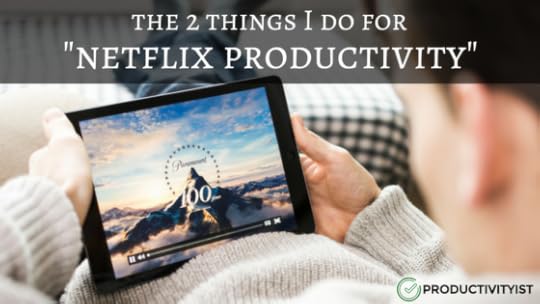
Netflix isn’t exactly considered a haven for productivity. But once you start leveraging some of its features, it winds up being more productive than most content-consuming platforms.
I should know because I watch Netflix regularly and still get all the things I need and want to do done. And I do this by doing these 2 things: tagging and clipping.
Tagging
In my to do list app (for personal use, it’s Todoist) I have created a “Netflix” label. So if there is anything I think of that I’m hoping is on Netflix, I can capture it and then attach the Netflix label to it. (I’ve even colour-coded it red to match the branding.)
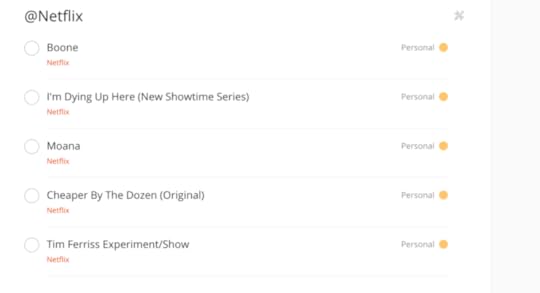
Then whenever I look at Netflix in the future, I can review any items that are labeled with that label. If anything that is labeled in the app is available for viewing on Netflix and it isn’t in my Netflix queue, I simply add it. Once it is in the queue, I check it off as completed. If it isn’t available on Netflix, I leave it until it is or I decide I no longer want – or care – to see it. (When that happens, I delete it from the app.)
This keeps my mind free of storing movies or shows I want to see on Netflix and keeps me more focused when I sit down to watch Netflix. It also keeps me from using any other apps to manage this as I used to use Evernote for this.
Clipping
I use the Todoist web clipper to quickly capture shows that are on Netflix that I find on the website What’s New on Netflix. I check this website out once per week as it is updated daily and reveals what Netflix has added to its catalog over time.
Since Netflix isn’t exactly the easiest service to navigate in terms of discovery (although it has gotten better in recent years), using this site is helpful as it keeps me from scanning more than necessary.
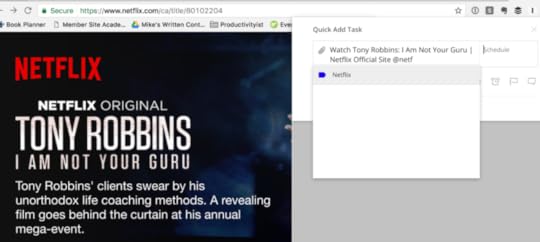
I still attach the Netflix label when I clip things from the site so that the tagging workflow I described earlier doesn’t get affected.
(Note: You can use this strategy with a wide variety of to do list apps, some of which use tagging instead of labelling.)
What About Evernote?
You can also use Evernote to achieve the same thing if you do the following:
Create a notebook where you’ll put your Netflix shows/films you want to watch. You can either create a Netflix notebook or create an Entertainment notebook and simply use a Netflix tag for those notes you add that feature Netflix content.
Use the Evernote Web Cilpper as I use the Todoist one above.
If you find a show you want to watch, take a photo of your television screen. Then tag that note with Netflix and put it in the appropriate notebook. This approach is particularly efficient if you happen to be watching Netflix on your television and find something you didn’t see while browsing Netflix on the web.
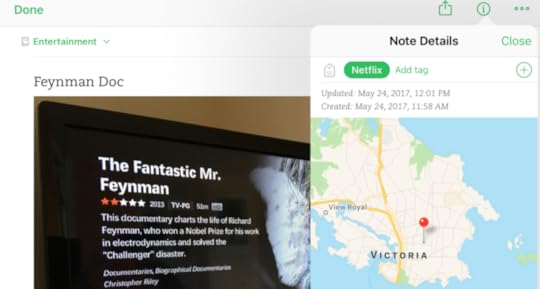
This process has been a huge help in keeping my Netflix viewing habits in check, saving me time every time I sit down to watch something on the service.
Before I let you go, if you’re looking for something to watch on Netflix that I recommend, I particularly enjoyed Minimalism: A Documentary About the Important Things from the team at The Minimalists. It features several folks that you’ve heard me speak with on The Productivityist Podcast (Patrick Rhone, Joshua Becker), and it is a film that will give you quite a bit to think about. (The irony of that statement is not lost on me.)
The post The 2 Things I Do for “Netflix Productivity” appeared first on Productivityist.
May 22, 2017
Being with Toku McCree
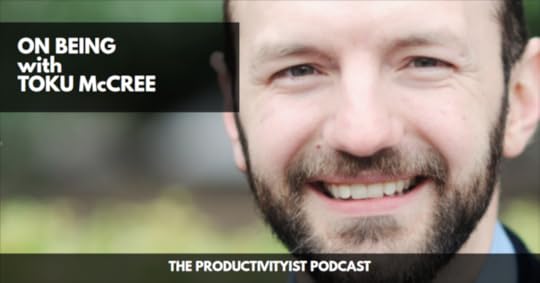
It ‘s been real treat chatting with this episode’s guest Toku McCree. Toku is a coach, teacher and the guy behind Unexecutive.com and Samurai Coaching Dojo.
His background working with rock stars and living in a Zen monastery certainly gives off a vibe that he’s less traditional than the usual, and he uses these experience to teach entrepreneurs and leaders an out-of-the-box mindset to redefine success not as the destination but as a part of the journey to an amazing life.
Our conversation focused on the the idea that obsessing over tactics could actually be ruining your business, and even your life. Some of the points Toku and I covered in our discussion includes:
An obsession with productivity and strategy that he’s noticed working with entrepreneurs, leaders, and CEOs (2:25).
The point in an individual’s growth when the focus shifts from what you’re doing to what you’re being, and how this can change everything in your life, thus creating a kind of efficiency with less friction (3:04).
How he had 30 jobs before he was 30 years old, and how a cycle of getting hired, learning, getting bored and leaving a job led to a realization that he remains dissatisfied (5:01).
Meeting someone in a party which eventually led him to live in a monastery for two and a half years, where he learned about happiness and fulfillment (6:22).
Questions to ask yourself to enable you to run your business, or life, with greater efficiency, and without being tied to a rigid process, system, tactic or tool (8:35).
How vulnerability is actually a strength than can create possibilities, and enable one to be more effective in dealing with relationships, teams, and business (12:46).
Why is it important for a successful person who may be so used to relating to the world in a place of strength to show and experience vulnerability (15:13).
How putting tactics in place with perfection as the goal is likened to running a tank with no weaknesses, and why this is not an ideal mentality (16:57).
The significance of practicing presence by stepping back and relaxing to generate insights towards improving your business and life (18:18).
Relevant Links:
Unexective.com
Samurai Coaching Dojo | An accelerator to practice the art of deep coaching.
Picking role models that matter | Toku McCree | TEDxZurichWomen – YouTube
Toku McCree (@unexecutive) | Twitter
Thanks for tuning in! Until next time, remember to stop guessing…and start going.
If you’re interested in supporting the podcast and receiving exclusive content while doing so, you’ll want to check out the patrons-only version of The Productivityist Podcast on Patreon. Also, remember to leave The Productivityist Podcast a rating and review on iTunes, or on whatever platform you’re listening to. I read every single bit of feedback we receive. I want to make this show better and with your help I can do that.
The post Being with Toku McCree appeared first on Productivityist.
May 18, 2017
7 Productivity Mistakes You Are Probably Making Every Day
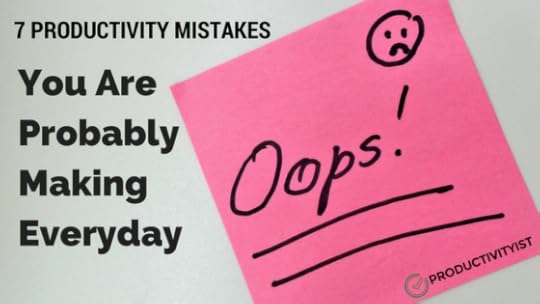
Today’s guest post is by Gloria Kopp. Gloria is a digital marketer and a business consultant from Manville city. She is a content manager at Australian help. Gloria is a regular contributor to such websites as Engadget, Academized, HuffingtonPost, etc.
Everyone wants to be more productive; that’s why lists of productivity tips are so popular online. If you just follow all of these tips, you’ll get more done every day. However, you’ve probably found that that isn’t the case. So, what’s the problem? Let’s look a closer at some common productivity mistakes and how you can avoid them.
1. Avoiding Distracting Websites
There are many tools available that help you block out the rest of the internet while you work. Most of these tools give you just a blank screen or a reminder to start working. That’s ok for a while, but you can easily reach burnout by not taking breaks.
If you get mentally fatigued, it will take you longer to recover before you can get back to work. Instead, try using the Pomodoro technique. Work for 25 minutes straight, then take a 5-minute break to do whatever you like, including checking out websites and social media. You’ll get a lot more done this way.
2. Reward Yourself
If you’re looking to reach a specific goal, it’s easy to reward yourself when you’ve made some progress towards it. However, it’s not always helpful. For example, if you’re studying towards getting a scholarship, you may decide to reward yourself by stopping work for a day or so. This kind of reward can slow your progress and reduce your momentum. Instead, pick a reward that does not affect your work. For example, once you’ve reached your goal, have dinner at your favorite restaurant with a friend.
3. Not Being Realistic
You want to be more productive. That’s a great goal, right? If you just become more self-disciplined, you can get anything (and everything) done, right? That really isn’t true. There are limits to your personal productivity. You may have health issues. You have unique demands on your time. Your energy levels also play an important role in your productivity. The best way to be productive is to work around these issues. What is a productive day for somebody else may not be a successful one for you. For example, you may get some work done in the hours while the kids are at school, and then take a break from your task list when they are home. If you don’t have school-aged kids, your day will likely look very different.
4. Thinking Multitasking Is Effective
When you’re tackling your to-do list, you’re probably trying to do more than one task at once. After all, the most productive people are multi-taskers, right? In fact, that isn’t the case at all. Recent research has shown how multitasking does not help you get more done. For example, writing and editing at the same time doesn’t save you time. You’ll just spend more on your work.
5. Delaying Harder Tasks
It can be really tempting to put off the biggest–or most difficult–tasks until later in the day. Or you could just call this what it is: procrastination. You may want to do the smaller tasks on your list first, but this is a problem. What happens is you use this approach to put off the task you don’t want to do. Instead, tackle the hard task first. Get it done and out of the way. Then you’ll feel much more able to tackle the rest of your to-do list.
6. Not Knowing When You Are Most Productive
Everyone has a time of day when they’re most productive. Some people like to get up before everyone else and work in quiet. Some like to sleep in and then work late into the night. You need to find your most productive hours of the day, and make the most of them. Once you have, you’ll be amazed at what you can achieve.
7. Not Delegating Your Work
Being productive doesn’t mean that you need to get everything done yourself. In fact, this can hinder you in getting all of your tasks done in the day. Go through all of your daily tasks, and see what you can delegate to others. Maybe you need to hire a virtual assistant. Use your resources wisely, and you’ll see you’ll get a lot more done every day.
Once you’ve made these adjustments to your everyday habits, your productivity levels will skyrocket. Pick one today and try it out for yourself.
Do you know of any other productivity mistakes? Please share in the comments.
The post 7 Productivity Mistakes You Are Probably Making Every Day appeared first on Productivityist.
May 15, 2017
Speaking with Passion with Corey Poirier

My guest on this episode is fellow Canadian Corey Poirier. Corey is a keynote speaker, sales professional, entrepreneur, and the host of Conversations with Passion Radio Show where he has interviewed over 4,000 “super-achievers.”
A passionate speaker who wants to share with people his craft, Corey is behind the Passion Cure and The Speaking Program. It is through these avenues that he reaches out to people, coach those who are interested in developing their communication skills, and feature those who have been successful in their life’s passions.
Corey and I had a similar path in our lives that took us to what we’re doing now, and that is just one of the things we chatted about in this episode. Other areas we touched on are:
His journey starting with a career in sales, then shifting to stand-up comedy before finally transitioning into his passion for public speaking (2:20).
Our similar background in performance arts, and things that we didn’t enjoy as much in that field (5:50).
How people’s feedback propelled him into diving into passion as a speaker (10:43).
What people fear when it comes to communicating and public speaking, and how to get comfortable on stage (15:48).
The importance of tackling tasks and goals in small chunks that are easily achievable – whether in public speaking or productivity – until you’re ready to take on the big one (19:49).
How having a buddy to practice whatever it is that you’re passionate about or want to conquer gives you higher chances of success (20:40).
The structure of The Speaking Program (21:55).
Questions to ask oneself to help find your true passion, and how to take that first ‘baby step’ towards living that passion. (13:25; 25:31).
A productivity reminder to ensure that pursuing your passion is not interrupted – and becomes successful (28:03).
Relevant Links:
That Speaker Guy | Corey Poirier
Corey Poirier
How People Crush Fears and Expand Comfort Zones | Corey Poirier | TEDxCanmore – YouTube
Toastmasters International
The Speaking Program
The Passion Cure brings you the Conversations With PASSION! Radio Show
Corey Poirier (@thatspeakerguy) | Twitter
Weeding Your Life with Corey Poirier | Productivityist
Thanks for tuning in! Until next time, remember to stop guessing…and start going.
If you’re interested in supporting the podcast and receiving exclusive content while doing so, you’ll want to check out the patrons-only version of The Productivityist Podcast on Patreon. Also, remember to leave The Productivityist Podcast a rating and review on iTunes, or on whatever platform you’re listening to. I read every single bit of feedback we receive. I want to make this show better and with your help I can do that.
The post Speaking with Passion with Corey Poirier appeared first on Productivityist.
May 11, 2017
Move Past The Small Stuff And Focus On The Big Picture
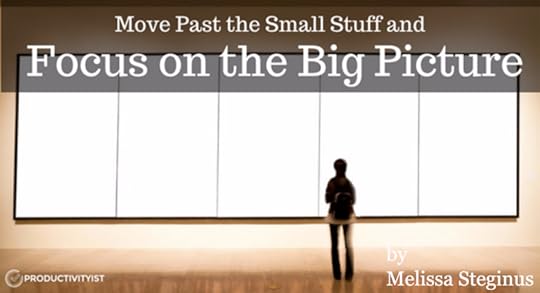
In our fast-paced world of digital connection and multiple roles, it can be easy to lose track of our goals (and even ourselves). I’d like to give you some steps you can take today to look within yourself and reconnect to what you truly want. Once you know this, then you’ll be able to move in the direction that’s right for you. (After all, isn’t that what personal productivity is all about?)
Step 1: The 30-minute Appointment You Need On Your Calendar
Schedule 30 minutes with yourself every single day. This simple step is one of the most transformative practices in personal productivity and wellbeing.
I wake up 30 minutes earlier in the morning to have time to myself before I even think of getting ready for work. Sometimes I spend that half hour on my yoga mat and other times I play with my pup in the backyard. No TV. No phone. No computer. Disconnect to reconnect.
How To Start Today: Set aside short chunks of time for introspection and observation. Do things that make you feel calm and connected to yourself, your thoughts, and your environment. Start small with a five-minute morning meditation or a 15-minute walk at lunch.
During this time, a number of thoughts might pop into your head. This is completely normal. If something is important, acknowledge it, jot it down on your phone or a piece of paper, and move on. If you’re anything like me and find yourself in a thought hurricane, I find it helps to close your eyes. Direct your attention to your breathing. Focusing on something autonomous is an excellent way to clear your mind.
You might also consider keeping a journal. Getting your thoughts and ideas onto paper is a great exercise for organization, clarity, and accountability. This practice also allows you to look back and observe how your way of thinking has changed over time.
Keep in mind: You deserve more than leftover time after you finish all of your tasks and responsibilities. Spending time with yourself is something you do intentionally. Make time.
Step 2: Choose Your Course And Set Sail
When you practice step one regularly, you gradually become more aware of who you are and what you value. You also give yourself the time and space to explore those things a bit deeper.
Maybe you will find something that you like and are good at doing. That’s great! Practice that. If you enjoy being creative but can only draw stick people, that’s great too. The important thing is to find something (or maybe many things) important to you, and do that something regularly.
If you feel like you don’t have time for your thing(s), please see step one. Is it important to you? If so, make time for it.
How To Start Today: Begin by asking yourself a series of questions. When do you feel the happiest? Whether it’s when you’re creating something or spending time with the ones you love, think about how you most enjoy spending your time. Shouldn’t everything else you do lead toward creating more time and ways to do what you enjoy and value?
If the concept of “happiness” seems foggy or elusive, what intrigues you? What makes you curious? Learn more about that. What goals do you want to achieve? What might you want your life to look like?
Write down words, activities, or values that resonate with you (i.e. connection, creativity, exploration, family, health, etc.). Settle on a few themes you’d like to prioritize and begin brainstorming ways you can progress towards enhancing different areas of your life. Then practice these things regularly – even if you have to schedule them into your day for the next six months.
Keep In Mind: This is a process (not a one-time activity) and requires practice and patience. You may not be where you want to be yet, but you’re moving in the right direction. The key is to do your best to keep that momentum.
Step 3: Save Your Appetite For The Main Course
In the words of Bill Gates, “Most people overestimate what they can do in one year and underestimate what they can do in ten years.”
To move big picture goals forward, make them your priority. If you fill up on snacks and bread (meaningless routines or mundane tasks), you won’t have room for the main course (those things from step two that make you happy). Bill Gates’ quote is similar to our parents’ reminders to save our appetite for dinner rather than fill up on the small stuff with no nutritional value.
How To Start Today: With a better idea of what you want, you can begin to eliminate what you don’t necessarily need. First, stop buying things you don’t need. De-clutter your physical space and find richness in experience, connection, and simplicity. Second, stop accepting responsibilities or opportunities that do not interest you. This approach equates to mental and emotional de-cluttering, which provides you more space and energy for your goals.
Unless a task is required, if an opportunity arises and doesn’t excite you (or match you big picture goals), say “no.” It’s all too easy to fill our plates with mediocre or flavourless tasks. Those kinds of tasks will prevent you from having the time, space, and energy to work on the things that make us shout, “YES!!”. Start prioritizing what you want by saying “no” to what you don’t.
Keep In Mind: Don’t feel guilty in saying “no” to things that don’t resonate with you. Setting boundaries isn’t being selfish; it’s pursuing your personal growth. There is a big difference.
Step 4: Acknowledge Your Obstacles To Move Past Them
We’re taught to fear words like “challenge” and “struggle.” The truth, however, is that these are necessary to our growth as humans. While it’s easy to resist starting something new for fear of looking inexperienced, my suggestion is to do it anyway. Try that new hobby, activity, sport, course, fitness regime, etc. that you’ve always wanted to. Forget how you might look and focus on the fact that you’re learning something different and reaching new goals.
When I dove into rock climbing, I struggled with intimidation, frustration, and an incredible amount of callouses. Yet, it’s the struggle (and the falling) that brings me closer to my goals, my community, and myself.
How To Start Today: Craft your list of priorities (step two) into specific goals for yourself. Leave space beside or underneath each goal to write the obstacles you face (or might face) for each. Contemplate each obstacle and brainstorm how you plan to overcome it. Who will keep you accountable? How will you document your progress? When will you schedule the time to pursue this goal? And so on.
This proactive practice addresses potential issues before they arise, providing a structure that can increase your self-confidence, transform your habits, and shift your mindset before you even dive in. You’re ahead already!
Keep In Mind: Be gentle with yourself. Your life is a work in progress. You will get there – wherever your “there” might be. For now, connect with yourself and what you want. And mindfully move forward.
There is no doubt we all face a variety of challenges each day. When you apply these four steps, you will find it easier to focus on the big picture. I’d like to challenge you to put one of these steps into practice today. And once you have success with that one, move onto one of the other steps.
Which of these steps would you like to put into practice first? Please share in the comments below.
The post Move Past The Small Stuff And Focus On The Big Picture appeared first on Productivityist.
May 8, 2017
The Magic of Manifestation with Jen Mazer
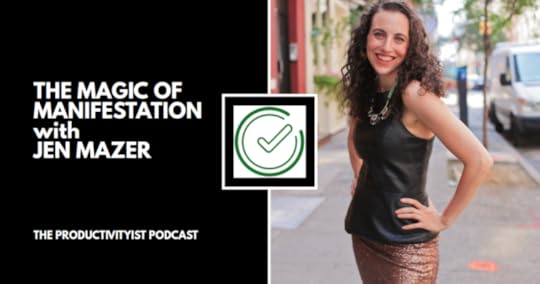
Do you want to live in an apartment with a jacuzzi in Manhattan – for free? Jen Mazer did that for 10 years (and so much more) – all through the power of manifestation.
Jen Mazer (a.k.a. the Queen of Manifestation) is a transformational speaker and coach, teaching people how to manifest their dreams and goals while making an impact on the world. She is the creator of the board game Sparked, and is also the author of the book Manifesting Made Easy: How to Harness the Law of Attraction to Get What You Really Want.
Manifesting gave Jen the chance to experience some of the most outrageous adventures – like attending a cocktail party hosted by Martin Scorsese, getting published in the New York Times, and even paying off debt. Jen’s the guest on this episode and she’ll share the power of manifestation in her life and how it can do the same for you.
We chatted about her background, the law of attraction, resistance, and even touched a bit on quantum physics. Here’s a rundown of what we covered during our conversation:
How she started in this niche and how her friends came up with the moniker “Queen of Manifestation” (1:50).
The skepticism and misconception that manifesting is solely about visualization and meditation, how productivity and action factors in, and why she isn’t a proponent of working too hard (3:20).
Her metaphor on how placing an order of the food you want in a restaurant is what manifesting is like to your life (4:50).
The importance of trusting your dreams as it could be foreshadowing what the universe wants for you, despite the limitations like not having time, experience, money (6:37).
The idea of seeing resistance as proof of movement and change, and obstacles as opportunities to experience new things (8:12).
The law of polarity, fostering awareness through what you want and don’t want, and reframing your intentions by positioning them so that they are positive and open to possibilities (11:30).
Reframing task management from “have to”, to “need to” to “get to” to make each task more impactful (16:33).
How her book breaks down manifesting concepts and techniques allowing anyone employ them, and the power of positivity and feeling positive inside before it even manifests (17:45).
What sparked the creation of the board game she co-created with her friend and how it is able to promote happiness, gratitude, inspiration and love (20:46).
Simple and easy ways to start manifesting, and a story of how an affirmation she wrote years ago manifested in her life (23:44).
Relevant Links
Queen of Manifestation
Manifesting Made Easy
Strategies for Getting Clear on Your Vision | Queen of Manifestation
How to Deal with Resistance | Queen of Manifestation
Manifesting Made Easy by Jane Mazer | Amazon
Sparked: The game with inspiration, heart & hilarity
Queen of Manifestation | Facebook
Jen Mazer (@JenMazer) | Twitter
Jen Mazer (@jenmazer) | Instagram
Thanks for tuning in! Until next time, remember to stop guessing…and start going.
If you’re interested in supporting the podcast and receiving exclusive content while doing so, you’ll want to check out the patrons-only version of The Productivityist Podcast on Patreon. Also, remember to leave The Productivityist Podcast a rating and review on iTunes, or on whatever platform you’re listening to. I read every single bit of feedback we receive. I want to make this show better and with your help I can do that.
The post The Magic of Manifestation with Jen Mazer appeared first on Productivityist.
May 1, 2017
The Problem with Productivity with Adam Quiney

Despite the two of us being based in Victoria, and within the same circle, I have only been able to touch base with Adam Quiney pretty recently. He is the kind of guy that I can talk to for hours, no beer needed.
In his words, he is an “obsessive perfectionist and high performer” who used to work as a project manager and lawyer. He is currently working as an executive coach where he teaches people how to live a life without compromise while creating the impact they want to.
On this episode, we talked about the problem with productivity, fostering relationships, books, among others. Some of the areas we also touched on includes:
How personal transformations involve self-awareness, feelings of disconnection or a pain point as the trigger (3:26).
The idea of the noble sacrifice brought about by caring too much or wanting to make a difference which can create disappointment, anxiety or heartbreak (4:20).
The ‘narrative’ we were made to believe that building relationships take time contradicting the concept of efficiency, and how to practice deepening intimacy congruent to productivity (6:20).
How the pursuit of productivity becomes a hindrance to our lives through too much dependence, and an anecdote on how this fixation can even ruin our relationships (9:15).
Steps on fixing this challenge by slowing down, gaining awareness on what efficiency is costing us, and facing the fear of what will happen if we’re not efficient (11:34).
A story highlighting the importance of taking ownership, and the role the ego plays in this conundrum (14:14).
His top picks when it comes to books which helped him understand human nature, and in turn help others (18:00).
The importance of balancing one’s boundaries and why he likened traversing life to riding a bike (20:50).
His insights on the work-life balance vs. work-life integration debacle, and what he thinks is a more plausible concept to aim for (23:35).
Relevant Links:
Evergrowth Coaching
Adam Quiney (@evergrowthadam) | Twitter
Ego is the Enemy by Ryan Holiday | Amazon
Shambala: The Sacred Path of the Warrior by Chogyam Trungpa
The Way of the Superior Man by David Deida | Amazon
Books by Neal Stephenson | Amazon
Books by Michael Singer | Amazon
Thanks for tuning in! Until next time, remember to stop guessing…and start going.
If you’re interested in supporting the podcast and receiving exclusive content while doing so, you’ll want to check out the patrons-only version of The Productivityist Podcast on Patreon. Also, remember to leave The Productivityist Podcast a rating and review on iTunes, or on whatever platform you’re listening to. I read every single bit of feedback we receive. I want to make this show better and with your help I can do that.
The post The Problem with Productivity with Adam Quiney appeared first on Productivityist.
April 27, 2017
An Easy Way To Stay Motivated And Productive
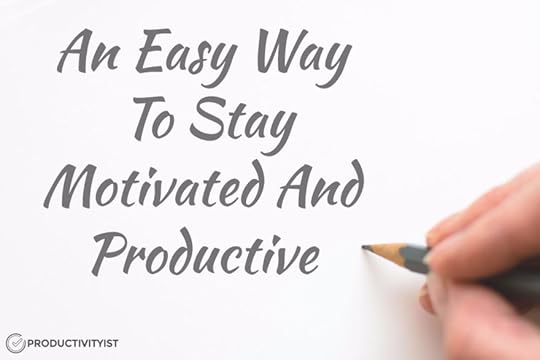
We all know about the to-do list. We use it everyday. Sometimes, we even obsess over it. We watch our to-do list shrink, and we watch it grow. Well, let’s step away from your to-do list for a moment.
Instead, I’d like to tell you about another list. This list has power and can give you serious momentum. So what is this list?
It’s called the “got done list.”
The got done list is a list of things you’ve accomplished. Best of all, the got done list is flexible. It can have items on it that you’ve already done today. Or the tasks you accomplished yesterday or any other time in the past.
Here’s the easy way to make a got done list.
1. Stop for a moment.
Just for a minute or two. Take a few deep breaths and step away from the screen. This is a perfect time to take a walk and get some fresh air. (Before you go, grab a piece of paper and a pen.)
2. Think about what you did yesterday.
If nothing comes to mind immediately, think of things that come to mind over the last week, month or even year. Try to focus on things that matter to you.
3. Write down your accomplishments.
Paper works best here because it is more personal. When you jot down your accomplishments on the page in ink, it has more weight than words on a screen.
Now whenever you feel overwhelmed, or need a boost of motivation, you can briefly celebrate your success with this list.
Then you can move forward.
Want to make the got done list even more powerful? Make it part of your journaling or daily log. Just a few lines about the major tasks you’ve accomplished can fuel you tomorrow (and beyond). Put this list in Evernote, and you have a record from the past that can help guide you today.
It’s easy to focus on your to-do list. But if that is all you do, you’re only looking at the missing pieces of the puzzle. Take a step back and gaze at what you’ve done so far.
The got done list represents the times you’ve done things right. The got done list shows the times you were productive. Even if you didn’t get the results you wanted, the point is you accomplished something.
That alone is worth celebrating (if even only for a brief moment). Once you’ve accomplished something, you’re able to learn from the experience. When you apply what you’ve learned, and you’ll find yourself moving forward.
What do you think? Are you going to create a got done list? Please let me know in the comments.
The post An Easy Way To Stay Motivated And Productive appeared first on Productivityist.
April 24, 2017
The Power of Pursuit with Kelsey Humphreys

This episode’s guest is an amazing woman that I’ve been “pursuing” to get into the podcast for a while. She’s the host and producer of The Pursuit, a talk show and podcast where she interviews influencers and the who’s who of business.
Kelsey Humphreys is a media entrepreneur, success coach and consultant, a motivational journalist who’s written for Entrepreneur Magazine and The Huffington Post (among others), and the author of the book Go Solo: How to Quit the Job You Hate and Start a Small Business You Love.
After finding that the content available on success and entrepreneurship was not very “beginner-friendly”, she made it her mission to break it down for those still doing the grind, helping people not to give up in the crucial first few years of their pursuits. (Kelsey also has a background in performance arts which could be another reason I gravitated toward her content.)
Our conversation revolved around what happens on her show and her plans for it. Some of the things we talked about include:
The behind-the-scenes action in producing her show, the technical issues, choosing between production quality and valuable content, and learning that perfection can hold one back from productivity (5:22).
Her vision of hosting a traveling talk show and how she planned to set it apart from other podcasts and YouTube shows (6:58).
The show’s humble beginnings – shooting with an action cam, getting help from volunteers, family, and friends, investing on equipment, and building Kelsey’s team (11:05).
What Kelsey perceives as the “value-added experience” by interviewing people live, and why she prefers to go to the where the guests are (14:14).
Her interesting experience interviewing Kathy Griffin (16:49; 27:10).
Pre-game rituals, her staple questions, why she prefers not to bring her notes with her during the interview, and self-reminders to keep her in control of the interviews and provide quality content for her audience (18:10).
Giving up on college dreams, ticking off goals one by one, and her vision to become the “Ellen of entrepreneurship and success” (20:30).
Wanting to offer something new to the audience in the area of success and entrepreneurship through the book she’s currently writing (23:02).
The surreal experiences of landing interviews with Tony Robbins and Larry King (27:40).
The advice Kelsey imparts for people who have been pushing down their hopes and dreams (28:35).
Relevant Links:
Kelsey Humphreys | Kelsey Humphreys | Success for the Rest of Us!
Full Episodes Archive | The Pursuit with Kelsey Humphreys
Go Solo: How to Quit the Job You Hate and Start a Small Business You Love by Kelsey Humphreys | Amazon
Donald Miller | The Pursuit with Kelsey Humphreys
Jeremy Cowart | The Pursuit with Kelsey Humphreys
I’m Possible. | Jeremy Cowart
Kathy Griffin | The Pursuit with Kelsey Humphreys
Tony Robbins | The Pursuit with Kelsey Humphreys
Kelsey Humphreys | Facebook
Kelsey Humphreys (@KelseyHumphreys) | Twitter
Thanks for tuning in! Until next time, remember to stop guessing…and start going.
If you’re interested in supporting the podcast and receiving exclusive content while doing so, you’ll want to check out the patrons-only version of The Productivityist Podcast on Patreon. Also, remember to leave The Productivityist Podcast a rating and review on iTunes, or on whatever platform you’re listening to. I read every single bit of feedback we receive. I want to make this show better and with your help I can do that.
The post The Power of Pursuit with Kelsey Humphreys appeared first on Productivityist.



